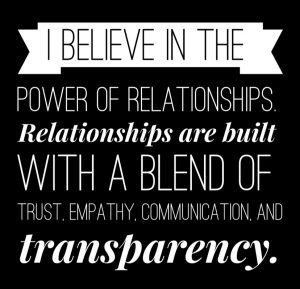TL;DR:
- It is important for leaders to be transparent, as it allows teams to come together easier and promotes authentic relationships.
- Keys to transparent leadership include sharing the whole story, asking questions, promoting sharing, tackling issues, encouraging individual voice, and consistent communication.
The date was March 18, 2020, and I was facilitating my very first staff Zoom meeting. There are memories from that morning that are as clear as if they occurred just a moment ago. The bright sun, my dog snuggled next to me, my husband scamming to Zoom bomb us in an attempt to make everyone laugh, and me quickly discovering the importance of the mute button! We found comfort in laughing as we navigated our new meeting venue together. After a few minutes of enjoying the novelty of Zooming, the tone in the virtual room shifted. The questions rolled in like rapid fire. When will we reopen? How will we deliver instruction? What about families who don’t have devices? Can we go into the building?
At that point, I didn’t have the answers. I paused and simply replied, “I don’t know.” We proceeded to talk about what I did know. We talked about what facts I had and hashed out ideas for next steps. I leaned into our trusting relationships and responded openly and honestly. I did not enter this meeting with all of the answers, rather I entered this meeting with the knowledge that we would figure things out…together. After some discussion, I heard it, “You don’t seem concerned, so I’m not concerned.” I was humbled. That statement will forever serve as a reminder of the position of a leader.

What exactly is transparency and why do we need it?
Transparency is being open, vulnerable, and allowing others inside your world. While certain times call for confidentiality, such as student privacy, medical issues, or security situations, staff who are kept in the loop and understand the whole picture are more likely to put their trust in their leadership. Understanding the whole picture helps facilitate solving problems. Transparency allows teams to come together easier and promotes authentic relationships. The effects of transparency can be profound. Most importantly, students do better when we are all happier at work.
How do we foster transparency? While I am hardly an expert, my own experiences and connections with others have helped me identify some important strategies to grow transparency.
Understanding the whole picture helps facilitate solving problems. Transparency allows teams to come together easier and promotes authentic relationships. The effects of transparency can be profound. Click To TweetSix Keys to Transparency
Key #1 to Transparent Leadership: Share the Whole Story
Transparency is about sharing your whole story…this way no one fills in the gaps with their own story! Transparency can look like expressing that you don’t know the answer and trusting that it will be figured out together. Interestingly, sharing that you don’t know the answer or that the answer hasn’t been decided yet is actually an answer—it’s part of the ongoing story.
Key #2 to Transparent Leadership: Ask Questions
Transparency is not only about sharing your story, it is also about knowing someone else’s story. AND…there is always more to the story! Ask open-ended questions. Find out the why behind a decision that was made before you react to the decision….you may be surprised! It is important to consider that perhaps we fill in the gaps to other people’s stories too.
Key #3 to Transparent Leadership: Promote Sharing
Create opportunities that invite individuals to open up. Begin meetings with a ‘check-in.’ An opening prompt is a great way to initiate a conversation that will help gauge the pulse of the room, find out how everyone is doing, and continue to cultivate relationships. The prompt could be as brief as sharing one word that describes how you are feeling. In virtual meetings, we sometimes utilize the chat feature to check-in. Click here to read more about the practice of meeting check-ins.
Key #4 to Transparent Leadership: Tackle Issues
While timing may be everything when managing a sensitive topic, don’t avoid the elephant in the room. As I mentioned earlier, when the whole story is not shared, it allows the opportunity for people to create their own story! It is normal to debate and disagree. Healthy discussions challenge and stretch our thinking, only making us better! Conflict, when handled properly, is actually constructive. Focus on the future and how to make things better for next time.
Key #5 to Transparent Leadership: Encourage Individual Voice
Opportunities for one-on-one conversations help us dive deeper into our relationships and focus specifically on personal needs. Scheduling regular individual meetings throughout the school year is a great way to connect and identify areas to provide support. The frequency of these meetings needs to be determined by the size of your staff and your schedule. However, I believe that if you put it on the calendar, it will happen! Sending out a check-in survey is a great tool to maintain individual connection during the time between face-to-face meetings (thank YOU Dr. Jeff Pricket for this amazing strategy). Click here to see a sample weekly check-in survey I share with staff.
[scroll down to keep reading]
Key #6 to Transparent Leadership: Consistent Communication
I believe that leaders need to communicate more than we realize. Consistent and frequent communication helps to reduce uncertainty and ensure that staff has received the message. Most importantly, discuss with staff how to communicate and what works best! This year, we landed on a weekly email update that is then placed in our staff Google Classroom to revisit at any time. We also had a weekly check-in meeting that later shifted to every other week as we settled into this unique school year. Check-ins include a Voxer group chat, individual monthly meetings, and a weekly check-in survey. I also aim to respond to all communications I receive within 24 hours.
Transparency certainly takes time, effort, and thought. How do you invest your time to ensure transparency?

It’s been said that the best leaders work themselves out of a job by multiplying the strengths and leadership capacity of those around them into action. The art and opportunity of leadership is to grow people. Leading by empowering is more than simply granting permission or authority. As the leader models desired attitudes and behaviours, true empowerment flows from the stated and demonstrated belief in the capacity of others to grow from and beyond these models. Connection is at the heart of this work. Empowered individuals know they have the go-ahead to act for the betterment of the community with the reassurance that someone will always have their back. – Brad Hughes, Principal (@brad_hughes)
See the full Leading by Empowering blog series here!
About Sari Goldberg McKeown
Sari Goldberg McKeown is a lifelong learner. She believes education is about who we teach, not just about what we teach. Sari is passionate about culture, relationships, and learning from each other. She believes in the power of being a connected educator. As educators, we are better together! Sari has served as an educator in many K-12 roles for over fifteen years, including classroom teacher, literacy specialist, mentor, supervisor, and coordinator. Currently, Sari serves as a central office administrator and remote learning principal on Long Island, New York.
She is the co-founder and co-moderator of the #Read2Lead Twitter chat and Voxer group, co-founder of #UnitedWeLearn, and series contributor on the #MentorRoundTable webinar series. She is also honored to be a part of the EdCamp Long Island planning team. Currently, Sari is a doctoral student in the Ed.D. Educational Administration and Supervision program at St. John’s University. Sari is a proud wife to third grade teacher, Bob, and bonus mom to three amazing children.



